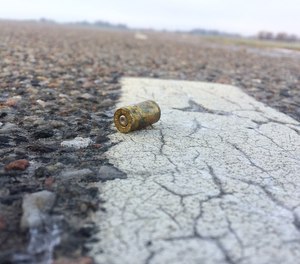The U.S. Sun: Gabby Petito’s autopsy ‘to reveal visible signs of trauma from attack’

Jennifer told The U.S. Sun why Gabby Petito’s full autopsy results have yet to be released.
“The death was referred to as a homicide very quickly after her body was found. This generally indicates the cause of death was pretty apparent to those that found her. I would assume there was visible trauma consistent with some kind of attack (i.e. gunshot wounds, knife wounds, obvious signs of strangulation etc.). The official cause of death and the autopsy report will likely take weeks to release.”

Jen Shen quoted in Daily Journal story on at-home rape kits

Jen was quoted in a story in The Daily Journal covering Monterey County’s use of self-administered sexual assault evidence collection kits during the coronavirus quarantine:
Former San Diego Police Department crime laboratory director Jennifer Shen said sexual assault reporting is a major issue deserving of national attention and law enforcement should always be looking for new ways to ensure victims get the care they need and that reports lead to investigations and ultimately a trial. However she does not think remote rape kits are the answer.
“I don’t know that the general public is aware of how complicated and complex these kits are,” Shen said in a phone interview last week. “There are a lot of working groups in California that met for months and months and months that put together a sexual assault kit that does everything that needs to be done when showing that we’re collecting the best evidence possible. That includes blood vials for collecting blood, urine for conducting drug testing and then a variety of swabs for all over the body, public hair samples, fingernail clippings. All of these things are involved in a sexual assault kit. It is not reasonable to think that the victim, who has been traumatized, can take a kit like this and then collect all the evidence needed. ”
Read the full story at DailyJournal.com (subscription required)

Police One story on DNA testing

In its story on new DNA technologies, the San Diego Reader mentioned Jennifer Shen.
An excerpt:
A new method of DNA testing could solve more shootings
Criminologists thought it was impossible to get DNA off of shell casings, but a technique pioneered in the Netherlands is having notable results
Apr 8, 2019
This story was published in partnership with Wired.
By Ann Givens, The Trace
Police found 19 spent shell casings scattered in the San Diego street where Gregory Benton was murdered on April 12, 2014. Benton and his cousin had gone to buy cigarettes, a witness later said. As they returned to a family party, two men pulled up in a car behind them. They got out, and at least one of them opened fire.

Witnesses didn’t get a good look at the men or the car, so when police sat down to review their leads, the shell casings were the best evidence they had. They sent the casings to the San Diego Police Crime Lab, which just happened to be trying out a new DNA testing technique.
Previously, to remove DNA from casings, the lab would moisten a cotton swab and rub it over the metal. But their success rate was less than 1%. This was proving to be a problem for many cities across the country struggling to solve shootings and homicides. Police often find that shell casings they collect from a crime scene are their most valuable evidence. Ballistic testing can offer clues about what kind of gun was used and, sometimes, whether that same gun was used in another crime. But the casings seldom yielded fruitful DNA results, and the San Diego Police Department, like many others, had stopped testing them.
…
Testing the casings for DNA would likely delay getting a NIBIN lead. In San Diego, where police now ask for DNA testing on the majority of casings collected in homicides, it takes the lab about eight days from when police pick up a casing off the street to the time they get it into NIBIN. That’s about two days longer than it would otherwise take them.
“The DNA portion does slow down the NIBIN entries,” said San Diego lab director Jennifer Shen in an email. “Although we certainly think it is worth it, as do our customers.”
Read the full story at PoliceOne.com

Wired: A New Method of DNA Testing Could Solve More Shootings
Forensic expert Jennifer Shen comments in Wired Magazine about the 2014 murder case of Gregory Benton and how the San Diego Police Department Crime Lab obtained DNA off the shell casings.

Jen Shen quoted in San Diego Reader

 In its story on the investigation of murder suspect Kevin Brown, the San Diego Reader mentioned Jennifer Shen.
In its story on the investigation of murder suspect Kevin Brown, the San Diego Reader mentioned Jennifer Shen.
An excerpt:
“Lab Supervisor Patrick O’Donnell stated he remembered Brown had a reputation of unusual behavior during the time of his employment,” Lambert wrote in the affidavit. “I determined additional follow up interviews needed to be conducted with former and current coworkers of Kevin Brown’s at the San Diego Police Department Lab…. O’Donnell stated he never associated with Brown outside of work and stated Brown’s reputation was only rumor to him.”
Lambert said Brown often made awkward jokes and once asked a female coworker to model for him for his photography group.
Another former colleague said she saw Brown leave the F Street Adult Book Store during his lunch hour. His zipper was allegedly down.
Fellow criminalist Annette Peer said one day Brown and a coworker watched a pornographic movie during work, though that coworker later denied it ever happening.
Lambert addressed the only other possible explanation for the presence of Brown’s DNA: cross-contamination. Lab manager Jennifer Shen told Lambert that cross-contamination was “not possible.” Brown had not worked on the case and therefore his DNA could not have been present.
Read the full story at SanDiegoReader.com

Jen Shen honored with San Diego Police Foundation’s “Women in Blue” Award


Jennifer Shen was honored as a trailblazer — one of just three women chosen to receive the 2014 Women in Blue Award from the San Diego Police Foundation.
“Women in Blue puts leadership, wisdom and inspiration in the spotlight. The stories of women leaders in law enforcement continue to impart wisdom that is both inspiring and practical, providing role models for young people aspiring to leadership in any field.”
Sara Napoli, president and CEO of the San Diego Police Foundation.
Read full story at SanDiegoMetro.com

Beethoven under the microscope: How did the composer die?

The San Diego Union Tribune did a special story on the intersection of forensics and music, featuring an interview with Jennifer Shen and Orchestra Nova’s conductor Jung-Ho Pak.
An excerpt:
Beethoven under the microscope
This sort of musical examination calls for the expertise of a forensic specialist
By ROXANA POPESCU, SPECIAL TO THE UNION-TRIBUNE

DETAILS
Orchestra Nova’s “Beethoven: CSI – Inside Ludwig’s Head”
When: Friday, 7:30 p.m.; Saturday, 8 p.m., Monday, 7:30 p.m.
Where: St. Paul’s Cathedral in Bankers Hill, Irwin M. Jacobs Qualcomm Hall in Sorrento Valley and Sherwood Auditorium in La Jolla, respectively.
Tickets: $22 and up.
Phone: (858) 350-0290
Online: sdco.org
Earlier this spring, Jennifer Shen, a forensic scientist with the San Diego County Medical Examiner, received an odd request in her e-mail inbox: A local music group was looking for help with a project.
It didn’t involve reconstructing a crime scene spatter by bloody spatter and analyzing traces of evidence — the daily grind for this chemist. This assignment was more highbrow, but no less noir:
Orchestra Nova, which renders classical music with unconventional pep, needed an expert to speak at the season finale, “CSI: Beethoven – Inside Ludwig’s Head.” The program features the Leonore Overture, the Fidelio Overture and Symphony No. 4, and a conversation about musical forensics. The performances take place Friday, Saturday and Monday at venues across the county.
Shen, a natural teacher who gives public lectures about her field, loves Beethoven, so she agreed to participate. Her mother “snorted and rolled her eyes. She thought it was an odd combination,” Shen recalled recently.
She wondered what she was getting herself into. Then she started looking into research about how the maestro died. And that’s when her obsession started.
Alongside Orchestra Nova’s conductor Jung-Ho Pak, Shen will invite audiences to contemplate two enduring mysteries: What killed Beethoven? And what drove him to create some of the most moving music of all time?
Beethoven died in agony on a stormy day in 1827. Thanks to a lock of his hair and skull fragments that have survived, scientists in this century have performed tests that bring them closer to determining a cause of death.
Read the full story at San Diego Union Tribune
